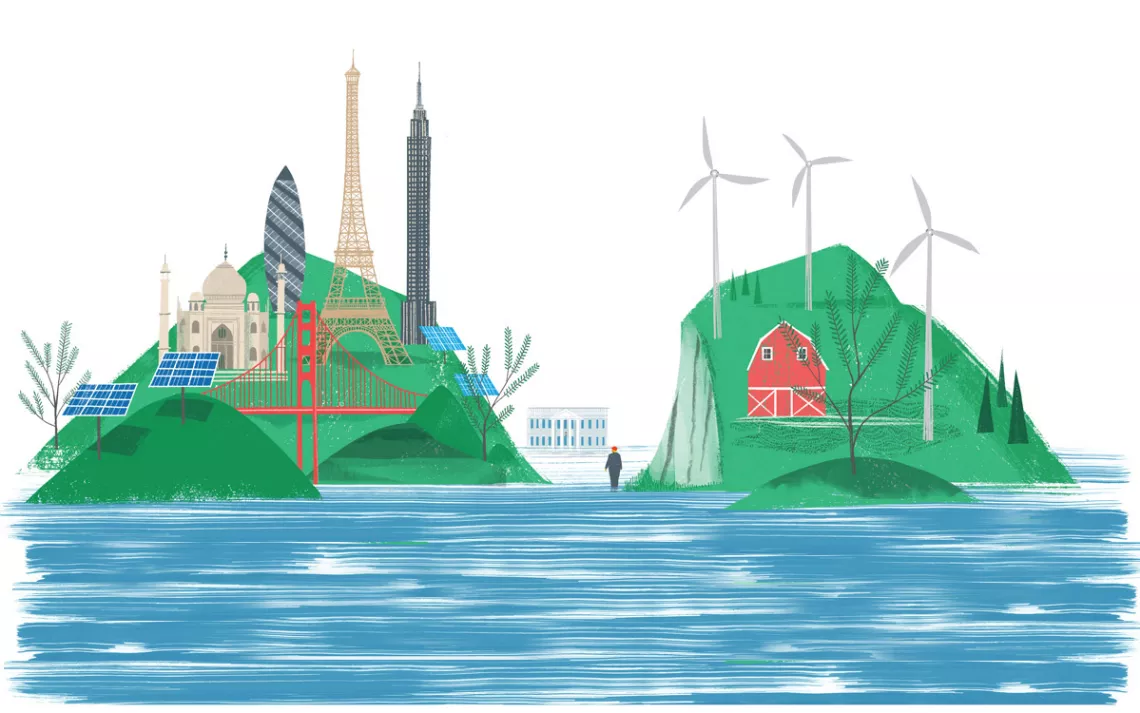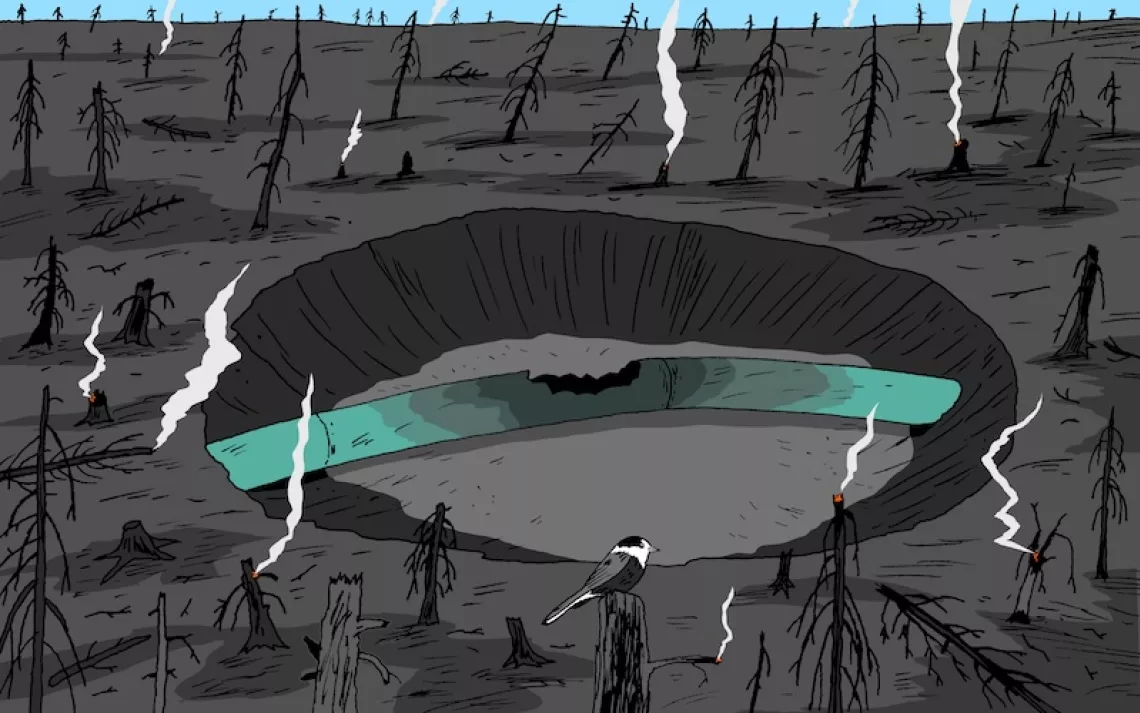The Diplomat Behind the Paris Climate Agreement Says the World Is Moving Forward Without Donald Trump
Christiana Figueres remains optimistic about tackling global warming

Illustration by Sam Kalda
When President Donald Trump announced, from the White House Rose Garden, his administration's intent to pull out of the Paris Agreement, many people were outraged. As the lead negotiator of the historic accord, I could understand people's frustration. But I was moved to thank the president. Trump's announcement provoked an unparalleled wave of support for the treaty. He shored up the world's resolve on climate action, and for that we can all be grateful.
Two years ago this December, acting under the UNFCCC, 195 nations negotiated the Paris Agreement, committing to do what it takes to keep temperature increases from rising more than 2°C (3.6°F) above preindustrial levels by the end of the century. We are already witnessing rapidly increasing climate impacts, from severe coral bleaching of the Great Barrier Reef to record temperatures, like the 129°F recorded in the Iranian city of Ahvaz. The catastrophic flooding in Houston, Texas, and Mumbai, India, have illustrated how climate change affects the most vulnerable the most.
When I was leading the UNFCCC process toward Paris, we knew that for the agreement to be steadfast, it was imperative that everybody—not just national governments—owned the process. With this in mind, we brought together a diverse cross section of people from all over the world so that they would understand the significance of a global agreement on climate change and how it could improve the future for us all.
The result? Paris is everyone's deal. It belongs to cities, businesses, nongovernmental organizations, and all of global civil society as much as it belongs to nation-states. So when President Trump attempted to destabilize the process by announcing his intent to withdraw, there was no domino effect of despair. Instead, he unleashed an inspirational countermovement in support of the Paris Agreement.
In the United States, this included the America's Pledge and We Are Still In campaigns, among others. Internationally, we've seen strengthened resolve from the developing nations, island states, and indigenous groups—all of whom would suffer greatly in a world of runaway heat. And this past summer, all of the G20 countries except for the United States reiterated their national commitments to the Paris Agreement.
California governor Jerry Brown announced plans for a Climate Action Summit, to be held in San Francisco in September 2018. "We in California and in states all across America believe it's time to act, and that's why at this Climate Action Summit we're going to get it done."
Brown's summit, as well as similar local efforts in support of the UNFCCC process, challenge the world to step up with climate action to match the challenge we face. For us to reach the Paris temperature goals, the national plans submitted by countries must be ratcheted up from their current status. We must start to demonstrate what going faster, further toward a climate-safe world really looks like—and to embolden our heads of state to follow suit. The moment for that to happen will be when the nations meet in 2020, on the five-year anniversary of the agreement. Countries also will have an opportunity to signal their intentions at the end of 2018, just after the California summit.
Despite the current U.S. administration's backsliding, strong climate leadership is all around us. We see it in cities—internationally with those in the C40 Cities, which have adopted Deadline 2020, and within the United States with the Sierra Club's Ready for 100 campaign. States and regions are also forging ahead on the Under2 MOU, a commitment by regional governments to achieve the Paris goals. Many businesses and investors are also taking responsibility for their actions, and individuals are being empowered through organizations such as Avaaz and 350.org.
This groundswell of support for Paris is buoyed by progress in the real economy (i.e., the production of goods and services) toward a low-carbon future. More than 100 multinational businesses have committed to going 100 percent renewable via the RE100 campaign, thereby creating demand for 146 terawatt-hours of clean electricity annually—enough to power all of Poland. U.S. jobs in wind power will more than double in the next seven years—making wind the fastest-growing job sector in the United States. Electric vehicle sales are surging. Britain, France, and India are just some of the nations vowing to ban internal combustion engines well before mid-century.
In finance, the world's largest investors are becoming wary of being stuck with stranded assets—fossil fuels that cannot be burned if we are to stay within the Paris temperature goals. In light of recommendations from the Financial Stability Board's Task Force on Climate-Related Financial Disclosures, they're clamoring for climate-risk disclosure from the companies they invest in. Today, more than half of the world's biggest investors, with funds worth $27 trillion, are considering climate change when making investment decisions. And all of us can still do more to push our banks and pension funds to ensure that our money is invested in line with a 2°C scenario.
Maintaining this momentum is critical, because time is running short. In order to meet the Paris goal and avoid the worst warming, the world needs to adhere to a strict carbon budget—the maximum amount of greenhouse gases that can be released before the 2°C temperature limit is breached. At our current emissions rate of 41 gigatons of CO2 per year, we will reach the midpoint of our remaining carbon budget within 15 years. Once the budget is exhausted, we will need to drop emissions to zero immediately—a leap that would be politically chaotic, unimaginably expensive, and socially unjust. As a group of colleagues and I wrote in a June essay for the journal Nature, to stretch out the carbon budget and soften the transition to renewable energy, we need rapid greenhouse gas reductions now to bend the curve of carbon emissions firmly downward by 2020, and then to halve emissions every decade after that.
Doing so is a monumental challenge; all the progress listed above is a fraction of what we need to see over the next three years, as we definitively decouple global development and growth from greenhouse gases.
I am optimistic that we will succeed in this, as we did in Paris. It is my conviction that—far from being embattled—our movement has become more participatory, more invigorated, and more democratic than ever before. A better world is calling, and we can achieve it by 2020. Millions of us are already on this mission; to ensure that we succeed, we need your bravery and fierce compassion. Be a stubborn climate optimist, foster a climate of change, and join the mission for a better future for everyone.
This article appeared in the November/December 2017 edition with the headline "We'll Always Have Paris."
WHAT YOU CAN DO
Get involved with the Ready for 100 campaign and tell your mayor that you want 100 percent clean and renewable energy in your community: sc.org/cleancities.
 The Magazine of The Sierra Club
The Magazine of The Sierra Club







